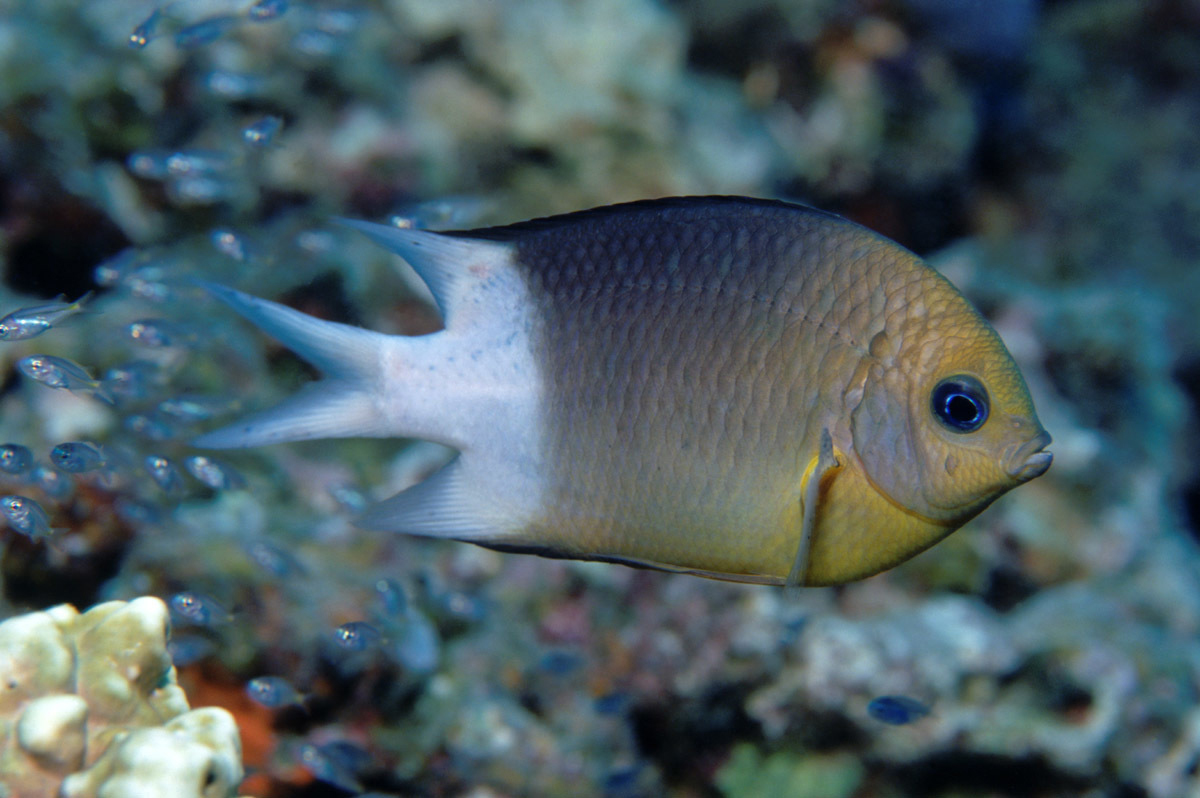- Classification
- ACTINOPTERYGII
- PERCIFORMES
- POMACENTRIDAE
- Acanthochromis
- polyacanthus
Spiny Puller, Acanthochromis polyacanthus (Bleeker 1855)
Other Names: Spiny Chromis, Spiny-tail Puller, Spotty-tail

A Spiny Puller, Acanthochromis polyacanthus, on Agincourt Reef Reef, outer Great Barrier Reef, Queensland, November 2005. Source: eschlogl / iNaturalist.org. License: CC by Attribution-NonCommercial
Summary:
This damselfish has a number of colour variants, and ranges from whitish to all brown or dark grey, sometimes with a white tail.
Unlike most damselfishes, the Spiny Puller lacks a pelagic larval stage, and the eggs hatch into small juveniles that are guarded by the parents.
Unlike most damselfishes, the Spiny Puller lacks a pelagic larval stage, and the eggs hatch into small juveniles that are guarded by the parents.
Cite this page as:
Bray, D.J. 2017, Acanthochromis polyacanthus in Fishes of Australia, accessed 02 Jul 2025, https://fishesofaustralia.net.au/Home/species/311
Spiny Puller, Acanthochromis polyacanthus (Bleeker 1855)
More Info
|
Distribution |
Cape Leveque to Cape Londonderry, the Kimberley region, Western Australia, Ashmore Reef and Hibernia Reef, Timor Sea, and the northern Great Barrier Reef, to Lady Musgrave Reef, Queensland; also reefs in the Coral Sea, and the Lord Howe Island region in the Tasman Sea. Elsewhere the species occurs in the tropical, west Pacific. |
|
Feeding |
Feeds on plankton and algae in the water column, and also steals algae from the farms of Ward's Damselfish (Pomacentrus wardi) and the Dusky Gregory (Stegastes nigricans). |
|
Biology |
Lacks a pelagic larval stage. Females lay large demersal eggs, and the larvae hatch after 15-17 days (other damselfishes hatch after about 5 days). The larvae are well-developed at hatching and swim and remain in a tight school near the nest site. For several weeks, they are guarded by the parents, and the juveniles gradually disperse to nearby areas on the reef. |
|
Author |
Bray, D.J. 2017 |
Spiny Puller, Acanthochromis polyacanthus (Bleeker 1855)
References
Allen, G.R. 1975. Damselfishes of the South Seas. New Jersey : T.F.H. Publications 237 pp. 251 figs.
Allen, G.R. 1991. Damselfishes of the World. Melle, Germany : Mergus Verlag 271 pp.
Allen, G.R. 1999. Altrichthys, a new genus of Damselfish (Pomacentridae) from Philippine seas with description of a new species. Revue fr. Aquariol. 26(1999): 23-28.
Allen, G.R. 1997. Marine Fishes of Tropical Australia and South-east Asia. Perth : Western Australian Museum 292 pp. 106 pls.
Allen, G. R. 2001. Family Pomacentridae. In: Carpenter, K.E. & Niem, T.H. (eds). The Living Marine Resources of the Western Central Pacific. FAO Species Identification Guide for Fisheries Purposes. Rome : FAO Vol. 6 pp. 3381-4218.
Allen, G.R. & Erdmann, M.V. 2012. Reef fishes of the East Indies. Perth : Tropical Reef Research 3 vols, 1260 pp.
Atherton, J.A. & McCormick, M. I. 2017. Kin recognition in embryonic damselfishes. Oikos 126: 1062–1069. doi:10.1111/oik.03597 247-270
Bay, L.K., R.H. Crozier & M.J. Caley. 2006. The relationship between population genetic structure and pelagic larval duration in coral reef fishes on the Great Barrier Reef. Marine Biology 149: 1247-1256.
Hutchins, J.B. 2001. Biodiversity of shallow reef fish assemblages in Western Australia using a rapid censusing technique. Records of the Western Australian Museum 20: 247-270.
Kavanagh, K. 1998. Notes on the frequency and function of glancing behaviour in juvenile Acanthochromis (Pomacentridae). Copeia 1998(2): 493-496.
Kavanagh, K.D. 2000. Larval brooding in the marine damselfish Acanthochromis polyacanthus (Pomacentridae) is correlated with highly divergent morphology, ontogeny and life-history traits. Bulletin of Marine Science 66(2): 321-337.
Kingsford, M.J. & J.M. Hughes. 2005. Patterns of growth, mortality, and size of the tropical damselfish Acanthochromis polyacanthus across the continental shelf of the Great Barrier Reef. Fishery Bulletin 103: 561-573.
Kuiter, R.H. 1996. Guide to Sea Fishes of Australia. A comprehensive reference for divers and fishermen. Sydney, NSW, Australia : New Holland Publishers xvii, 434 pp.
Leis, J.M. & B.M. Carson-Ewart. (eds). 2000. The larvae of Indo-Pacific coastal fishes. An identification guide to marine fish larvae. Brill, Leiden. 870 pp.
Marshall, T.C. 1964. Fishes of the Great Barrier Reef and Coastal Waters of Queensland. Sydney : Angus & Robertson 566 pp. 136 pls.
Miller-Sims, V.C., Gerlach, G., Kingsford, M.J. & Atema, J. 2008, Dispersal in the spiny damselfish, Acanthochromis polyacanthus, a coral reef fish species without a larval pelagic stage. Molecular Ecology 17(23): 5036-48. doi: 10.1111/j.1365-294X.2008.03986.x.
Patterson, H.M & Kingsford, M.J. 2005. Elemental signatures of Acanthochromis polyacanthus otoliths from the Great Barrier Reef have significant temporal, spatial, and between-brood variation. Coral Reefs 24(3): 360-369.
Planes, S., P J. Doherty & G. Bernardi. 2001. Strong genetic divergence among populations of a marine fish with limited dispersal, Acanthochromis polyacanthus, within the Great Barrier Reef and the Coral Sea. Evolution 55: 2263-227.
Randall, J.E., Allen, G.R. & Steene, R. 1990. Fishes of the Great Barrier Reef and Coral Sea. Bathurst : Crawford House Press 507 pp. figs.
Randall, J.E., Allen, G.R. & Steene, R. 1997. Fishes of the Great Barrier Reef and Coral Sea. Bathurst : Crawford House Press 557 pp. figs.
Rummer, J.L., Stecyk, J.A.W., Couturier, C.S., Watson, S-A., Nilsson, G.E., Munday, P.L. 2013. Elevated CO2 enhances aerobic scope of a coral reef fish. Conservation Physiology 1, doi:10.1093/conphys/cot023
Schunter C, Welch MJ, Ryu T, Zhang H, Berumen ML, Nilsson GE, Munday PL, Ravasi T. (2016) Molecular signatures of transgenerational response to ocean acidification in a species of reef fish. Nature Climate Change 6: 1014–1018. doi:10.1038/nclimate3087 Abstract
Van Herwerden, L. & P.J. Doherty. 2006. Contrasting genetic structures across two hybrid zones of a tropical reef fish, Acanthochromis polyacanthus (Bleeker 1855). Journal of Evolutionary Biology 19: 239-252.
Welch, M.J., S-A. Watson, J.Q. Welsh, M.I. McCormick & P.L. Munday. 2014. Effects of elevated CO2 on fish behaviour undiminished by transgenerational acclimation. Nature Climate Change doi:10.1038/nclimate2400














